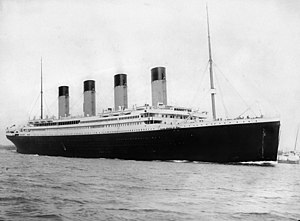ꯇꯥꯢꯇꯥꯅꯤꯛ
 ꯱꯰ ꯑꯦꯄ꯭ꯔꯤꯜ ꯱꯹꯱꯲ ꯇ ꯇꯥꯏꯇꯥꯅꯤꯛꯅ ꯁꯥꯎ꯭ꯊꯍꯦꯝꯇꯟ ꯊꯥꯗꯣꯛꯄ (Titanic departing Southampton on 10 April 1912)
| |
| History | |
|---|---|
| ꯏꯪꯂꯦꯟ | |
| Name: | ꯇꯥꯏꯇꯤꯅꯤꯛ |
| Owner: |
|
| Operator: | ꯍ꯭ꯋꯥꯏ꯭ꯇ ꯁ꯭ꯇꯥꯔ ꯂꯥꯏꯟ |
| Port of registry: |
{{Flag data UKGBI|Flagicon/core|variant=government|size=}} Liverpool, UK |
| Route: | ꯁꯥꯎꯠꯍꯦꯝꯇꯟ ꯗꯒꯤ ꯅ꯭ꯌꯨ ꯌꯣꯔꯛ ꯁꯤꯇꯤ |
| Ordered: | ꯱꯷ ꯁꯦꯞꯇꯦꯝꯕꯔ ꯱꯹꯰꯸ |
| Builder: | Harland and Wolff, ꯕꯦꯜꯐꯥꯁ꯭ꯇ |
| Cost: |
GB£1.5 million (£Error when using {{Inflation}}: |index=UK-GDP (parameter 1) not a recognized index. million in ꯲꯰꯱꯶) |
| Yard number: | ꯴꯰꯱ |
| Way number: | ꯴꯰꯰ |
| Laid down: | ꯳꯱ ꯃꯥꯔꯆ ꯱꯹꯰꯹ |
| Launched: | ꯳꯱ ꯃꯦ ꯱꯹꯱꯱ |
| Completed: | ꯲ ꯑꯦꯄ꯭ꯔꯤꯜ ꯱꯹꯱꯲ |
| Maiden voyage: | ꯇꯦꯝꯄ꯭ꯂꯦꯠ:Date and age |
| In service: | ꯱꯰-꯱꯵ ꯑꯦꯄ꯭ꯔꯤꯜ ꯱꯹꯱꯲ |
| Out of service: | ꯱꯵ ꯑꯦꯄ꯭ꯔꯤꯜ ꯱꯹꯱꯲ |
| Identification: |
|
| Fate: | Struck an iceberg 11:40 p.m. (ship's time) 14 April 1912 on her maiden voyage and sank 2 h 40 min later on 15 ꯑꯦꯄ꯭ꯔꯤꯜ 1912. |
| Status: | Wreck |
| General characteristics | |
| Class and type: | ꯇꯦꯝꯄ꯭ꯂꯦꯠ:Sclass- |
| Tonnage: | 46,328 GRT |
| Displacement: | ꯵꯲,꯳꯱꯰ ꯇꯟ |
| Length: | ꯸꯸꯲ ft ꯹ in (꯲꯶꯹.꯱ m) |
| Beam: | ꯹꯲ ft ꯶ in (꯲꯸.꯲ m) |
| Height: | ꯱꯷꯵ ft (꯵꯳.꯳ m) (keel to top of funnels) |
| Draught: | ꯳꯴ ft ꯷ in (꯱꯰.꯵ m) |
| Depth: | ꯶꯴ ft ꯶ in (꯱꯹.꯷ m) |
| Decks: | ꯹ (ꯑꯦ-ꯖꯤ) |
| Installed power: | ꯃꯅꯤꯡ ꯑꯅꯤ ꯄꯥꯟꯕ ꯕꯣꯏꯂꯔ ꯲꯴ ꯑꯃꯁꯨꯡ ꯃꯅꯤꯡ ꯑꯃꯇ ꯄꯥꯟꯕ ꯕꯣꯏꯂꯔ ꯵ ꯅ ꯄꯨꯟꯗꯨꯅ ꯃꯁꯥꯒꯤ/ꯃꯇꯥꯏꯒꯤ ꯄ꯭ꯔꯣꯄꯦꯂꯔꯁꯤꯡꯒꯤ ꯑꯍꯨꯝꯂꯛ ꯀꯥꯝꯈꯠꯄ ꯁ꯭ꯇꯤꯝ ꯏꯟꯖꯤ/ꯔꯦꯁꯤꯄ꯭ꯔꯣꯀꯦꯇꯤꯡ ꯁ꯭ꯇꯤꯝ ꯏꯟꯖꯤꯟ ꯊꯥꯛꯏ, ꯑꯃꯁꯨꯡ ꯄ꯭ꯔꯦꯁꯔ ꯅꯦꯝꯕ ꯇꯔꯕꯥꯏ꯭ꯟ ꯑꯃꯅ ꯃꯌꯥꯏꯒꯤ ꯄ꯭ꯔꯣꯄꯦꯂꯔꯕ;[꯳] ꯄꯨꯊꯣꯛꯄ: ꯴꯶,꯰꯰꯰ ꯍꯣꯔ꯭ꯁ ꯄꯥꯋꯔ (ꯑꯩꯆ꯬ꯄꯤ꯬) |
| Propulsion: | ꯕꯜꯦꯗ ꯑꯍꯨꯝ ꯄꯥꯟꯕ ꯃꯁꯥꯒꯤ (ꯃꯇꯥꯏꯒꯤ) ꯄ꯭ꯔꯣꯄꯦꯂꯔ ꯑꯅꯤ ꯑꯃꯁꯨꯡ ꯕꯜꯦꯗ ꯑꯍꯨꯝ ꯄꯥꯟꯕ ꯃꯌꯥꯏꯒꯤ ꯄ꯭ꯔꯣꯄꯦꯂꯔ ꯑꯃꯥ |
| Speed: | Cruising: ꯲꯱ kn (꯳꯹ km/h; ꯲꯴ mph). Max: ꯲꯳ kn (꯴꯳ km/h; ꯲꯶ mph) |
| Capacity: | Passengers: 2,435, crew: 892. Total: 3,327 (or 3,547 according to other sources) |
| Notes: | ꯂꯥꯏ꯭ꯐꯕꯣꯠ ꯃꯁꯤꯡ: ꯲꯰ (ꯃꯤꯑꯣꯏ ꯱,꯱꯷꯸ ꯆꯟꯕ) |
ꯇꯥꯏꯇꯥꯅꯤꯛ ꯑꯁꯤ ꯍꯋꯥꯏꯠ ꯁꯇꯥꯔꯂꯥꯏꯟ ꯅ ꯁꯥꯕ ꯑꯆꯧꯕ ꯍꯤꯖꯥꯎ ꯑꯃꯅꯤ ꯫
ꯁꯪꯒꯥꯕ ꯃꯇꯝꯗ ꯑꯥꯔ꯬ꯑꯦꯝ꯬ꯑꯦꯁ꯬ ꯇꯥꯏꯇꯥꯅꯤꯛ ꯑꯁꯤ ꯈ꯭ꯋꯥꯏꯗꯒꯤ ꯆꯥꯎꯕ ꯃꯤꯑꯣꯏꯕꯅ ꯁꯥꯕ ꯂꯦꯡꯗꯨꯅ ꯆꯠꯄ ꯄꯣꯠ ꯑꯣꯏꯇꯤ - ꯲꯶꯹ ꯃꯤꯇꯔ ꯁꯥꯡꯕ ꯑꯃꯁꯨꯡ ꯴꯶,꯰꯰꯰ ꯇꯟ ꯂꯨꯝꯕ ꯫ ꯃꯍꯥꯛ ꯑꯁꯤ ꯍ꯭ꯋꯥꯠ ꯁ꯭ꯇꯥꯔ ꯂꯥꯏ꯭ꯅꯅ ꯆꯂꯥꯏꯕ ꯑꯣꯂꯦꯝꯄꯤꯛ ꯀꯜꯥꯆꯀꯤ ꯑꯣꯁꯤꯟ ꯂꯥꯏꯅꯔ ꯑꯍꯨꯝꯒꯤ ꯃꯅꯨꯡꯗ ꯑꯃꯅꯤ, ꯑꯃꯗꯤ ꯕꯦꯜꯐꯥꯁ꯭ꯇꯀꯤ ꯍꯥꯔꯂꯦꯟ꯭ꯗ ꯑꯦꯟ꯭ꯗ ꯋꯣꯜ꯭ꯐꯀꯤ ꯍꯤ ꯁꯥꯐꯝꯗ ꯱꯹꯰꯹-꯱꯱ ꯗ ꯁꯥꯈꯤꯕꯅꯤ ꯫ On 10 April 1912, the Titanic departed on its maiden voyage from Southampton to New York.
On 14 April 1912, despite warnings of ice fields, the ship did not reduce speed and struck an iceberg shortly before midnight. The iceberg ripped a long gash in the side and the ship began to flood. Passengers were unaware and joked about the ice found on the deck. The Captain ordered the lifeboats to be filled and lowered, with women and children first. More than two hours after hitting the iceberg, Titanic sank into the Atlantic Ocea꯬
Notes Second of the 'Olympic' class, Yard No. 401 incorporated a number of design improvements and changes in the layout of the passenger accommodation following almost ten months operation of her older sister Olympic (Yard No. 400).
The main difference between the two ships, externally, was the glassing in of the forward end of the Promenade Deck; in operation it was found that spray was landing on Olympic’s deck making it slippery for 1st Class passengers.
Despite White Star’s concerns about the comfort of 1st and 2nd Class passengers this was not the primary reason for Titanic's construction. Her proper title is the 'Emigrant Ship Titanic' and without the record numbers of emigrants crossing the Atlantic ships like this would never have been constructed.
Time for the ‘Olympic’ class was running out long before an iceberg was sighted in Titanic’s path. The war clouds gathering across the Continent and, immediately after the Great War, restrictions on the numbers allowed to enter the United States, signalled the end of the giant emigrant ship era.
Titanic stands not only as one of the worst disasters at sea but also as a memorial to the zenith of mass migration across the world's oceans.
ꯃꯇꯦꯡ ꯂꯧꯔꯛꯐꯝ
[ꯁꯦꯝꯒꯠꯂꯨ | ꯁꯦꯝꯒꯠꯂꯛꯄꯒꯤ ꯍꯧꯔꯛꯐꯝ]- ↑ Titanic History, Facts and Stories.
- ↑ Titanic Centenary. Archived from the original on 6 January 2021 ꯫ Retrieved on 10 April 2021 ꯫
- ↑ Beveridge & Hall 2004, p. 1.
